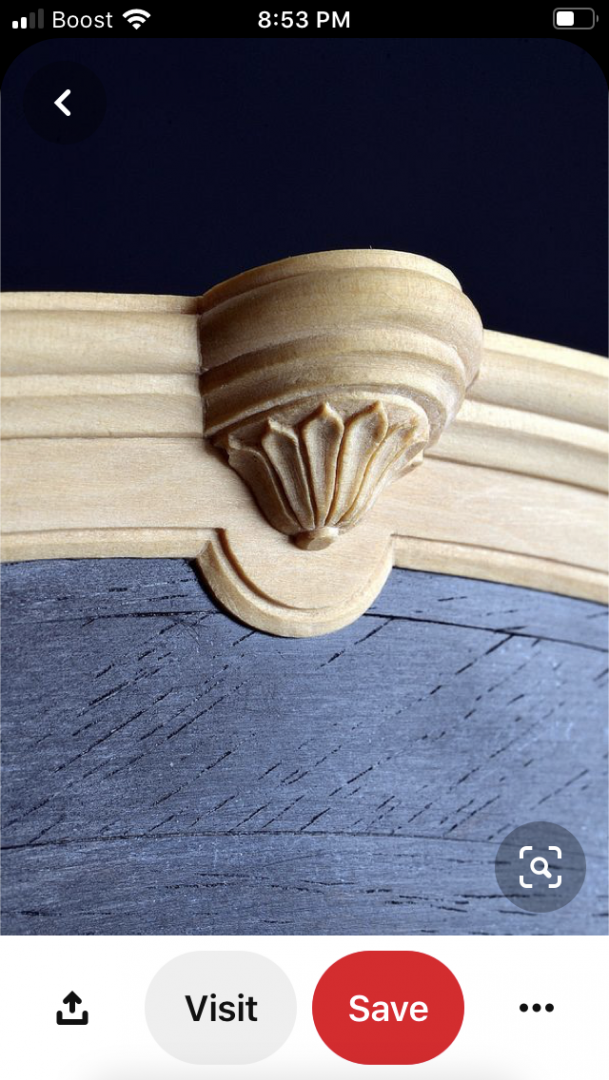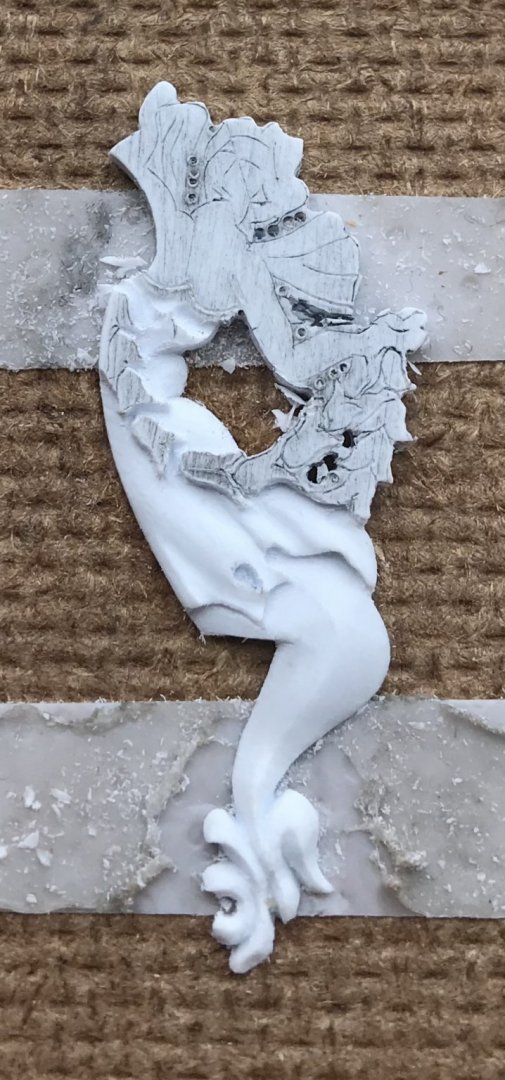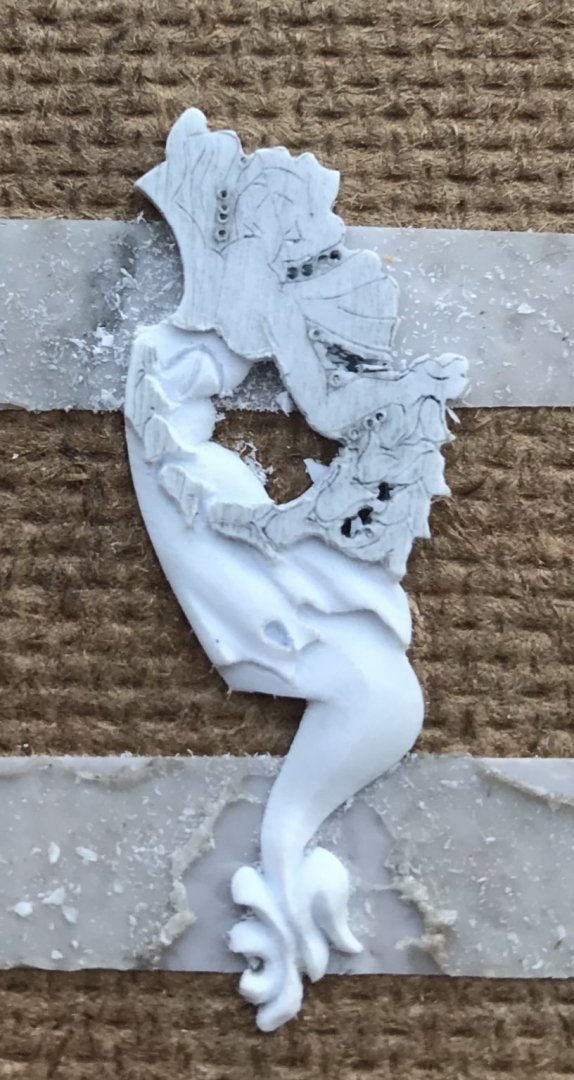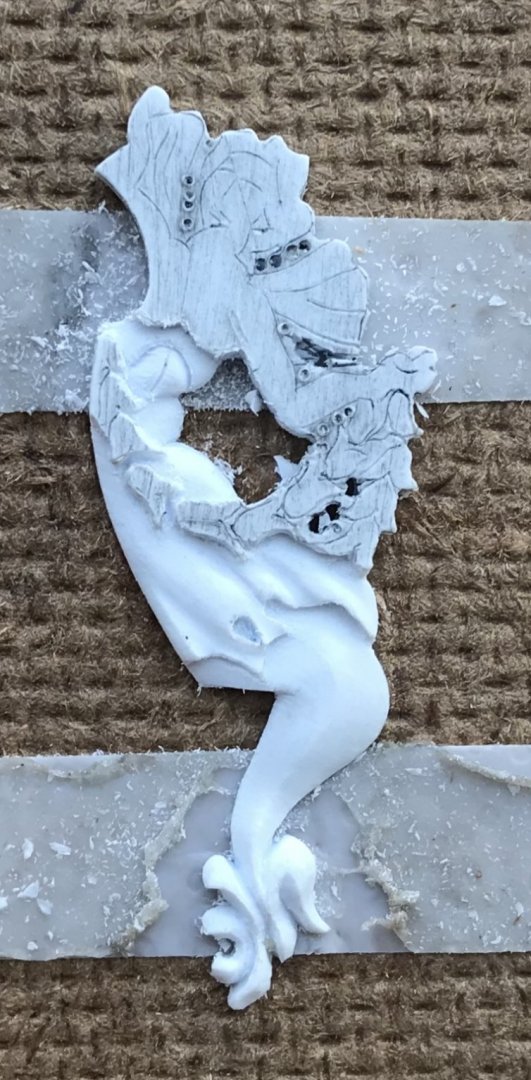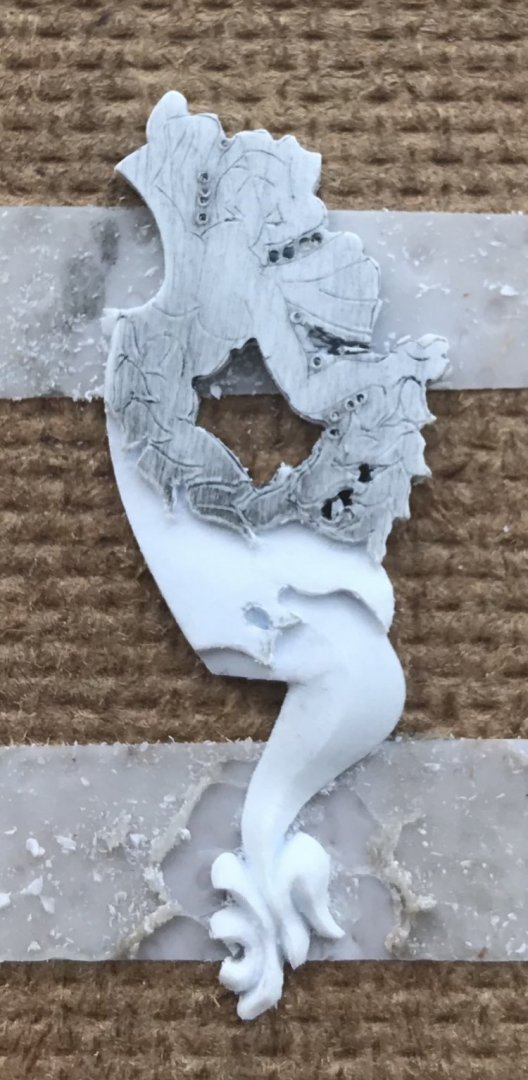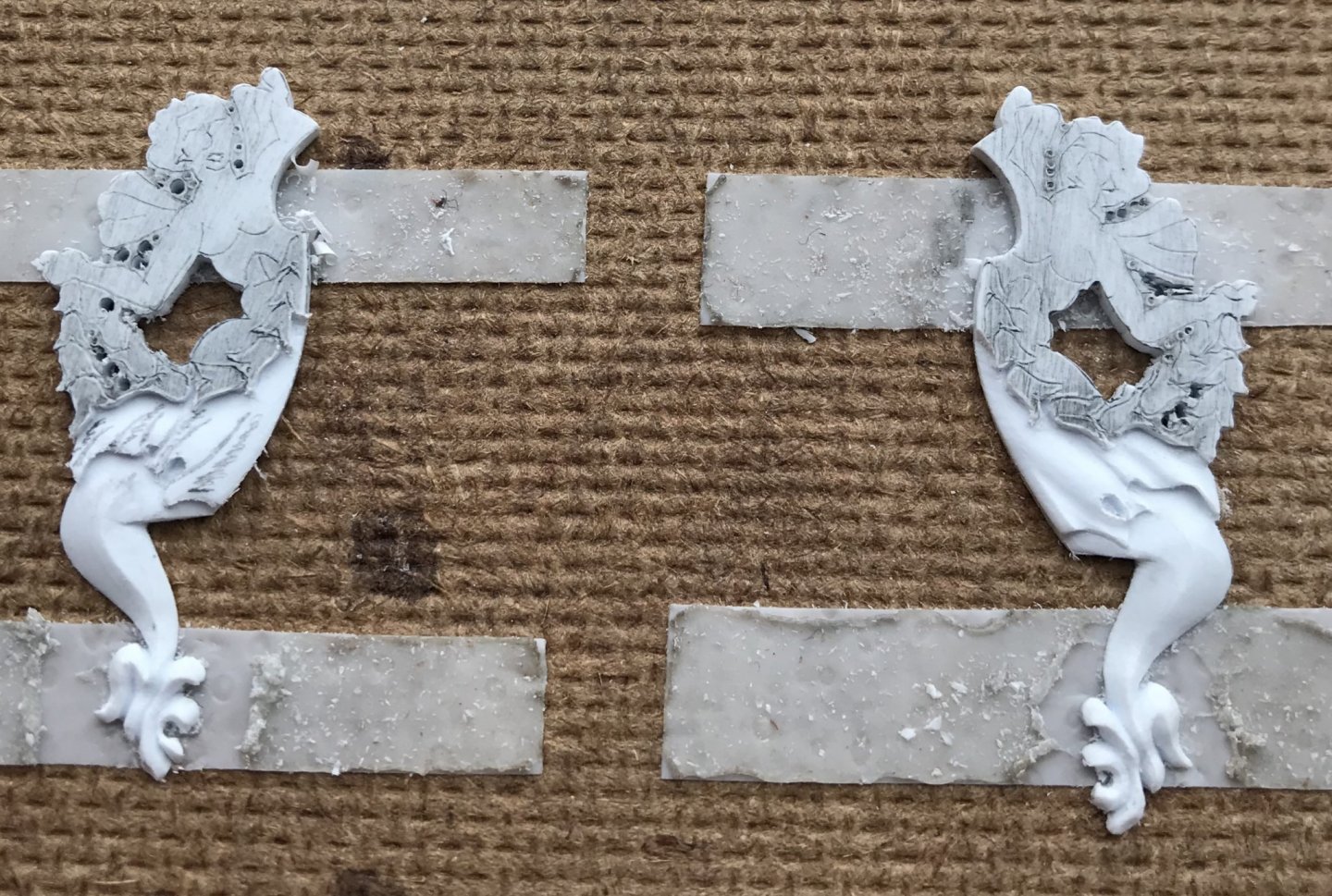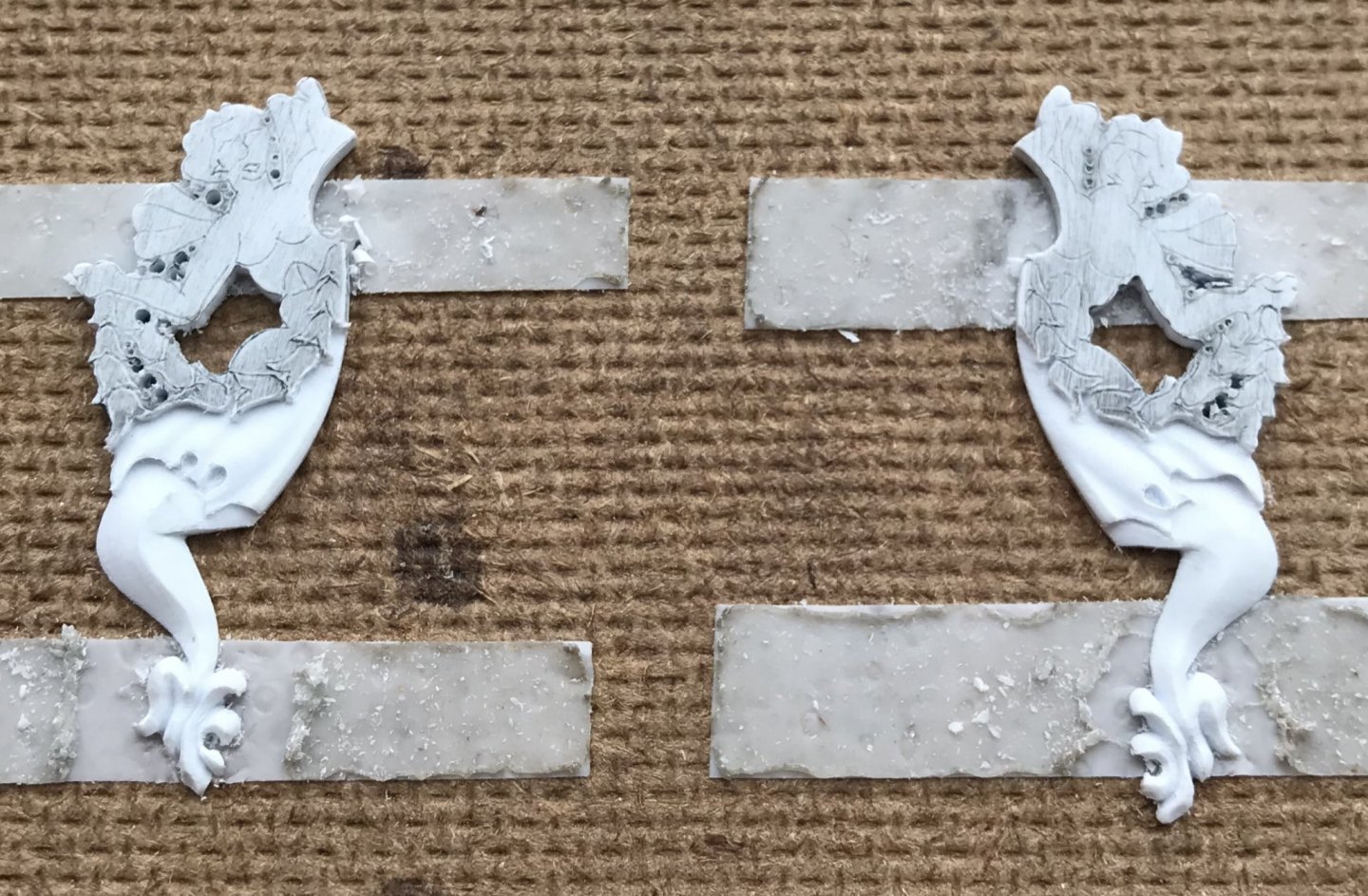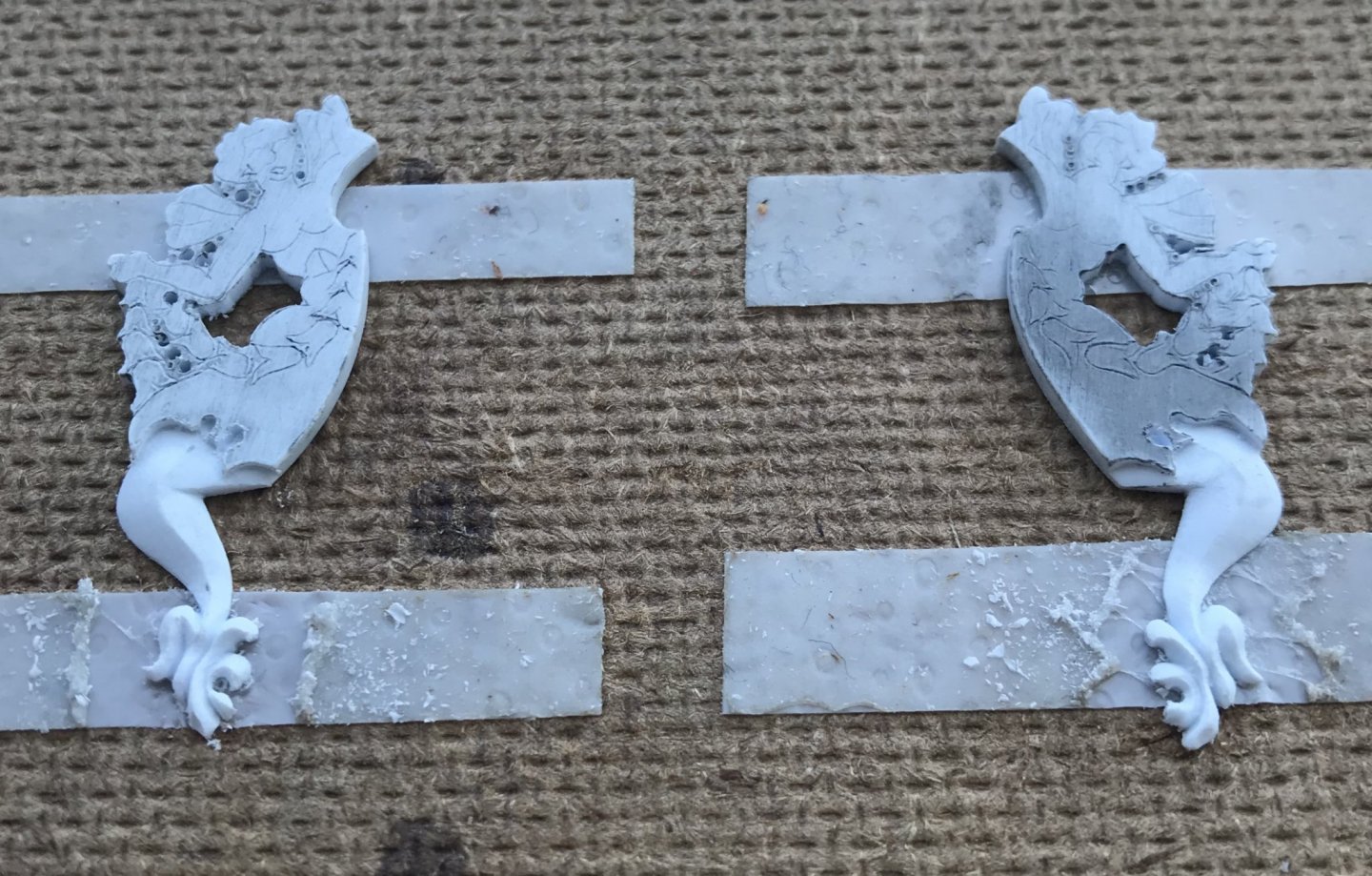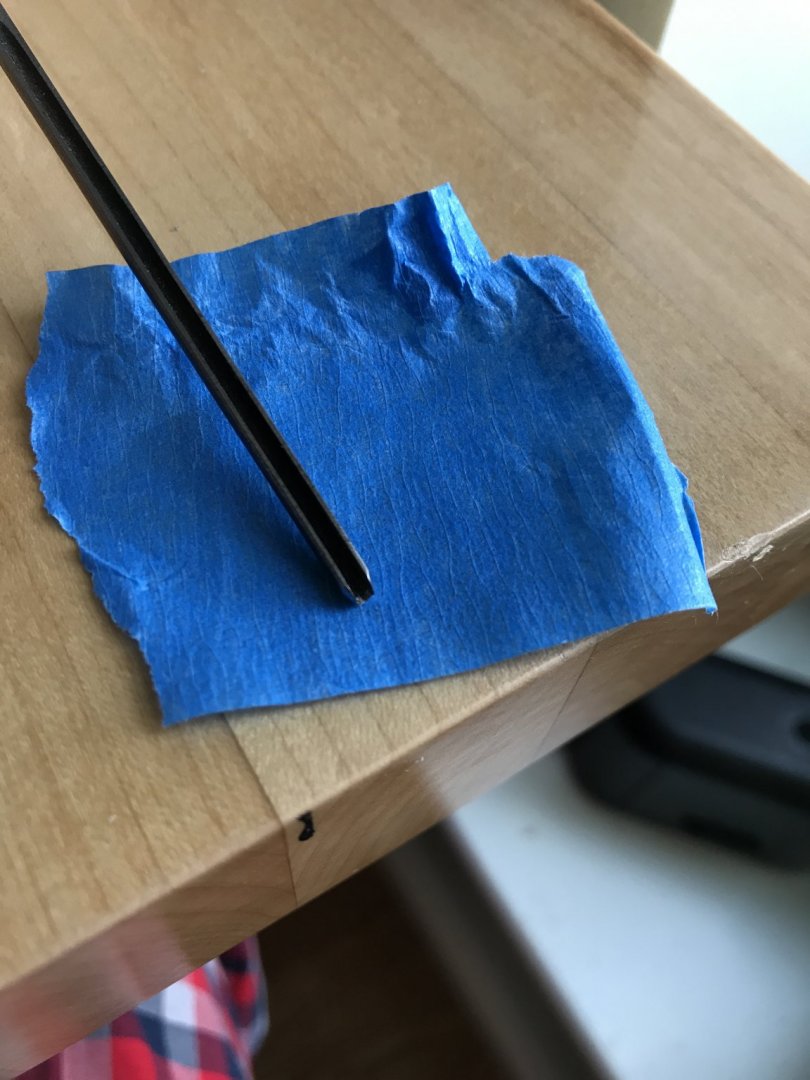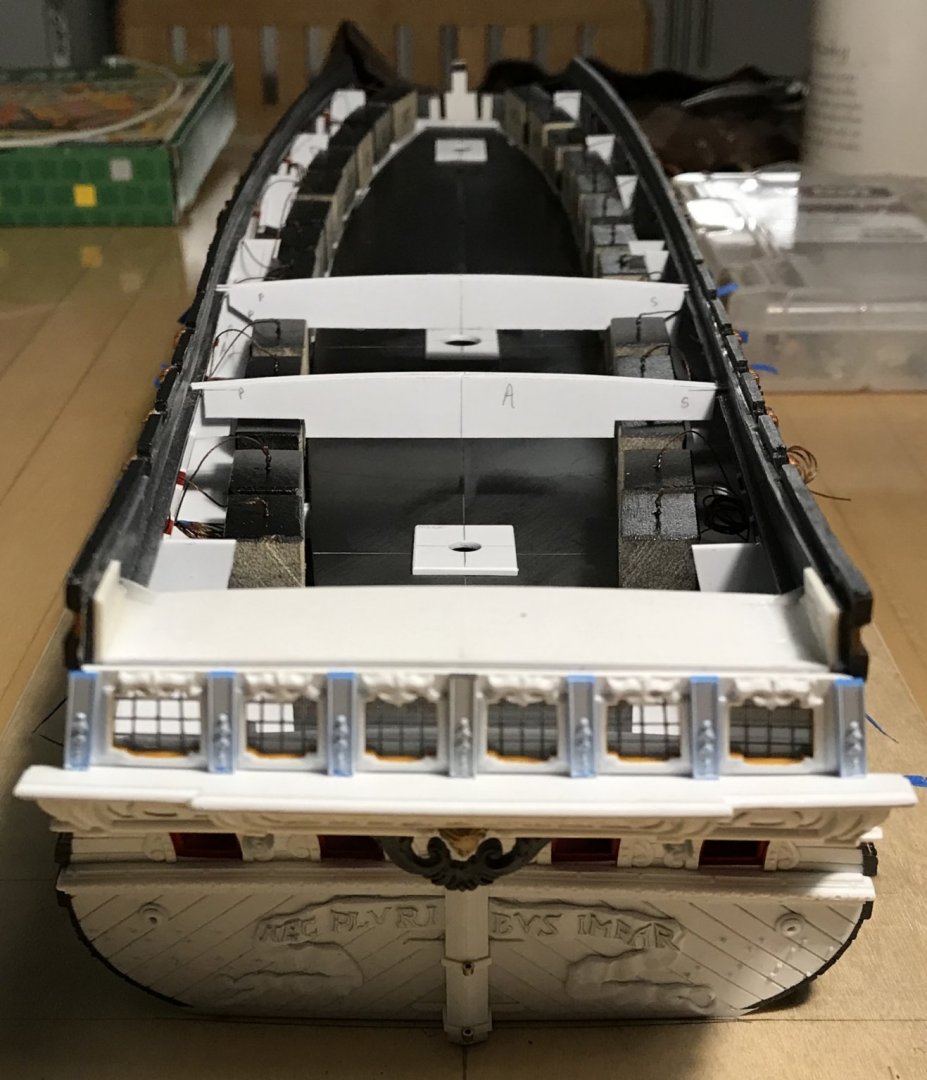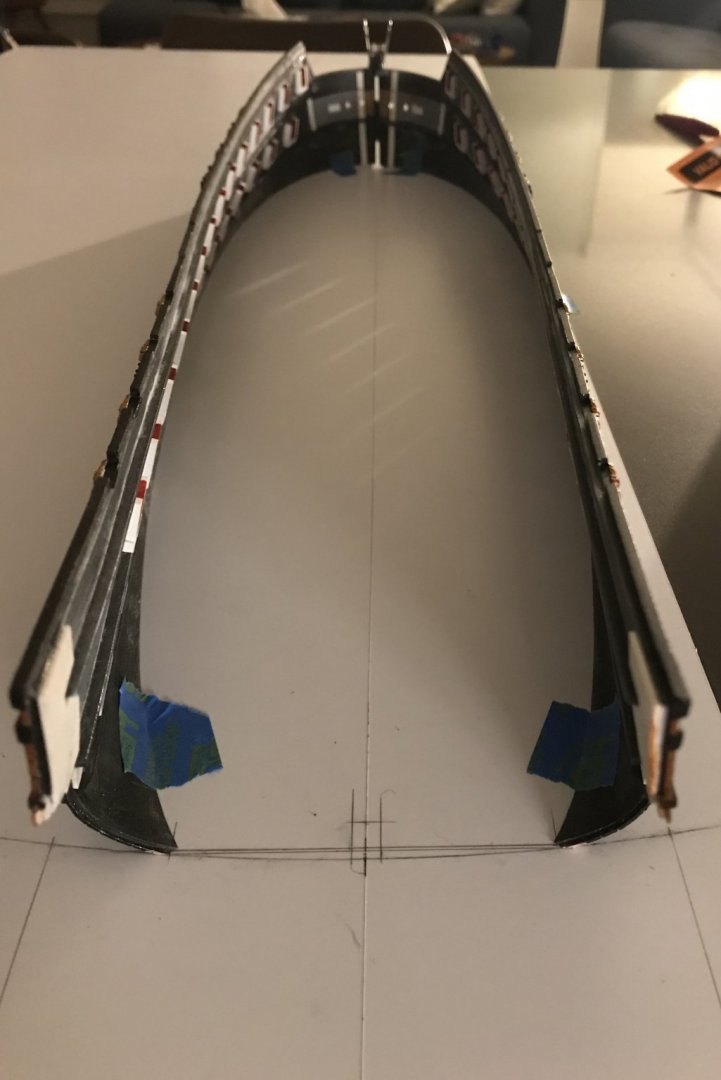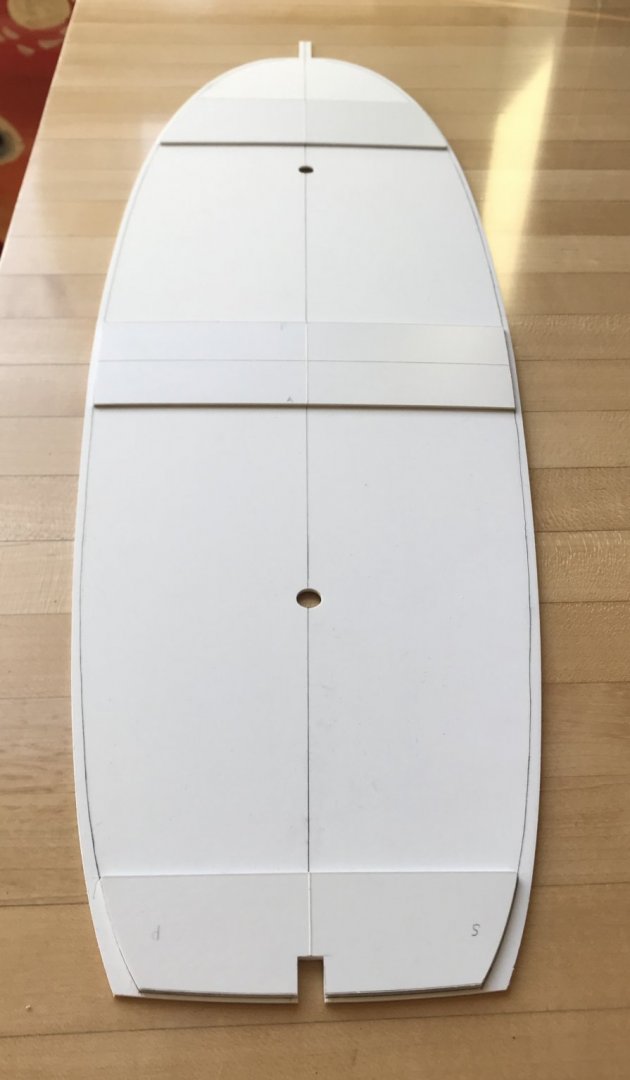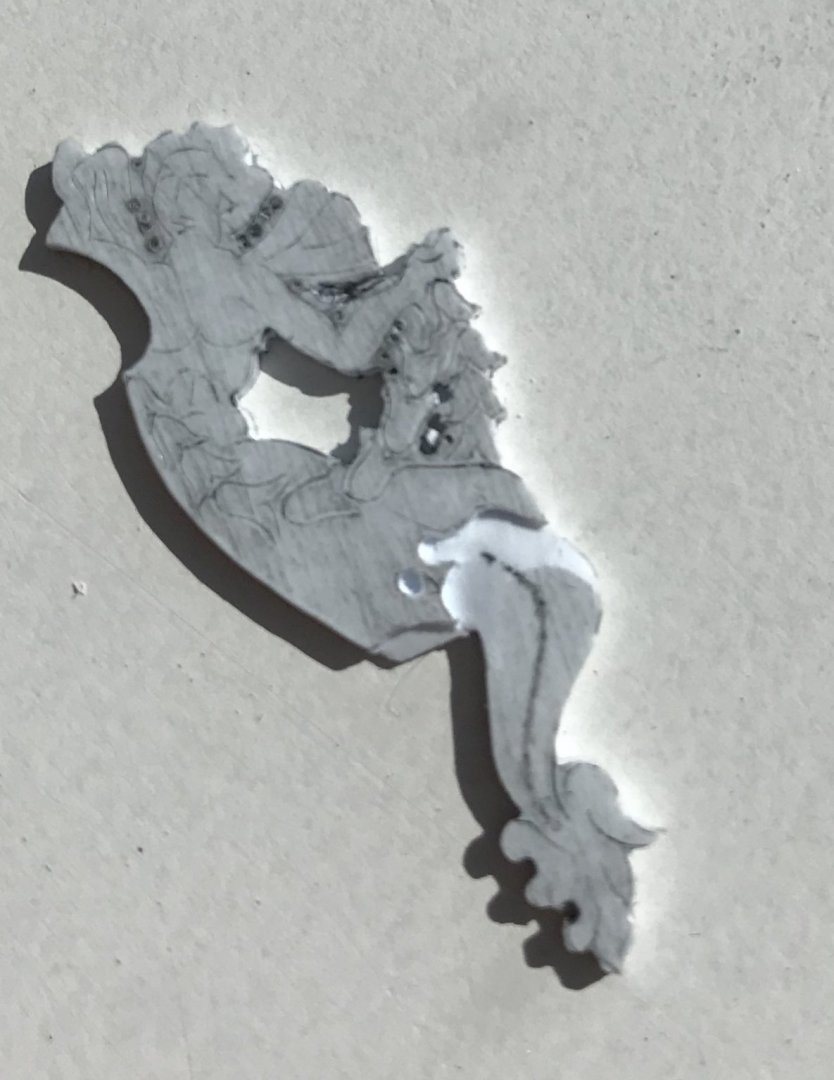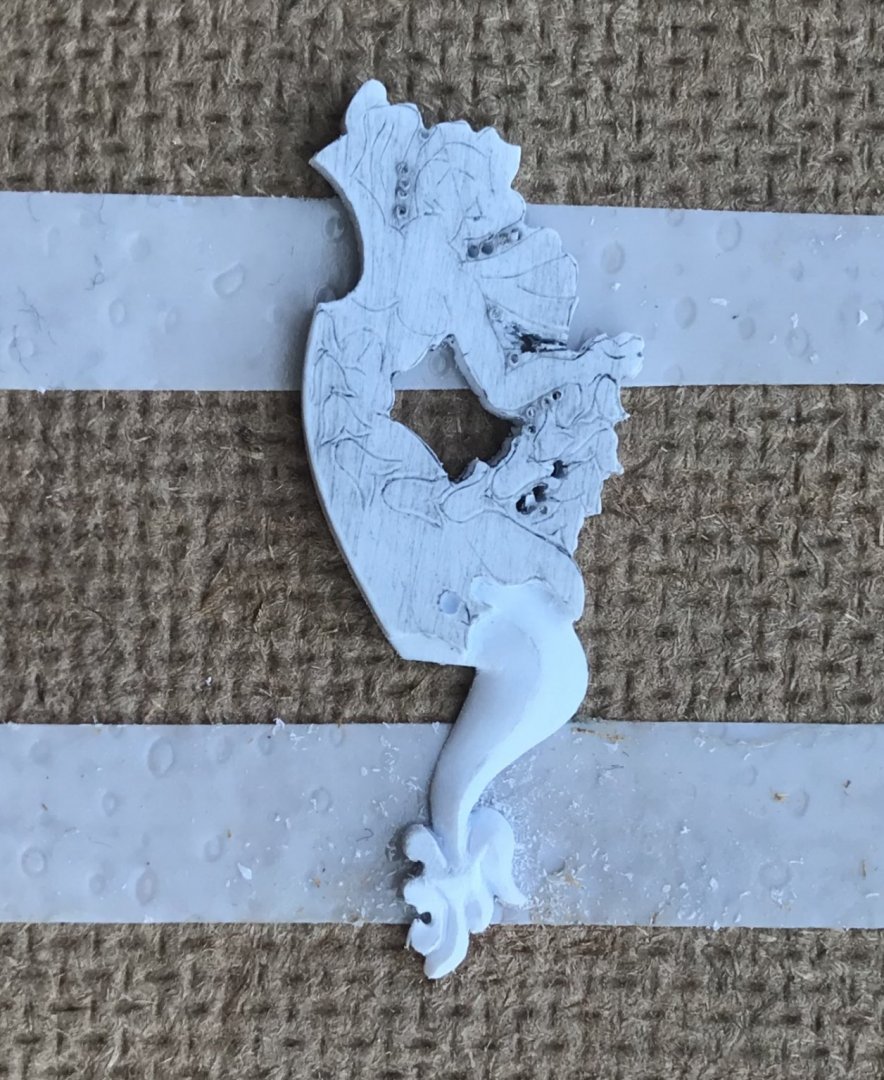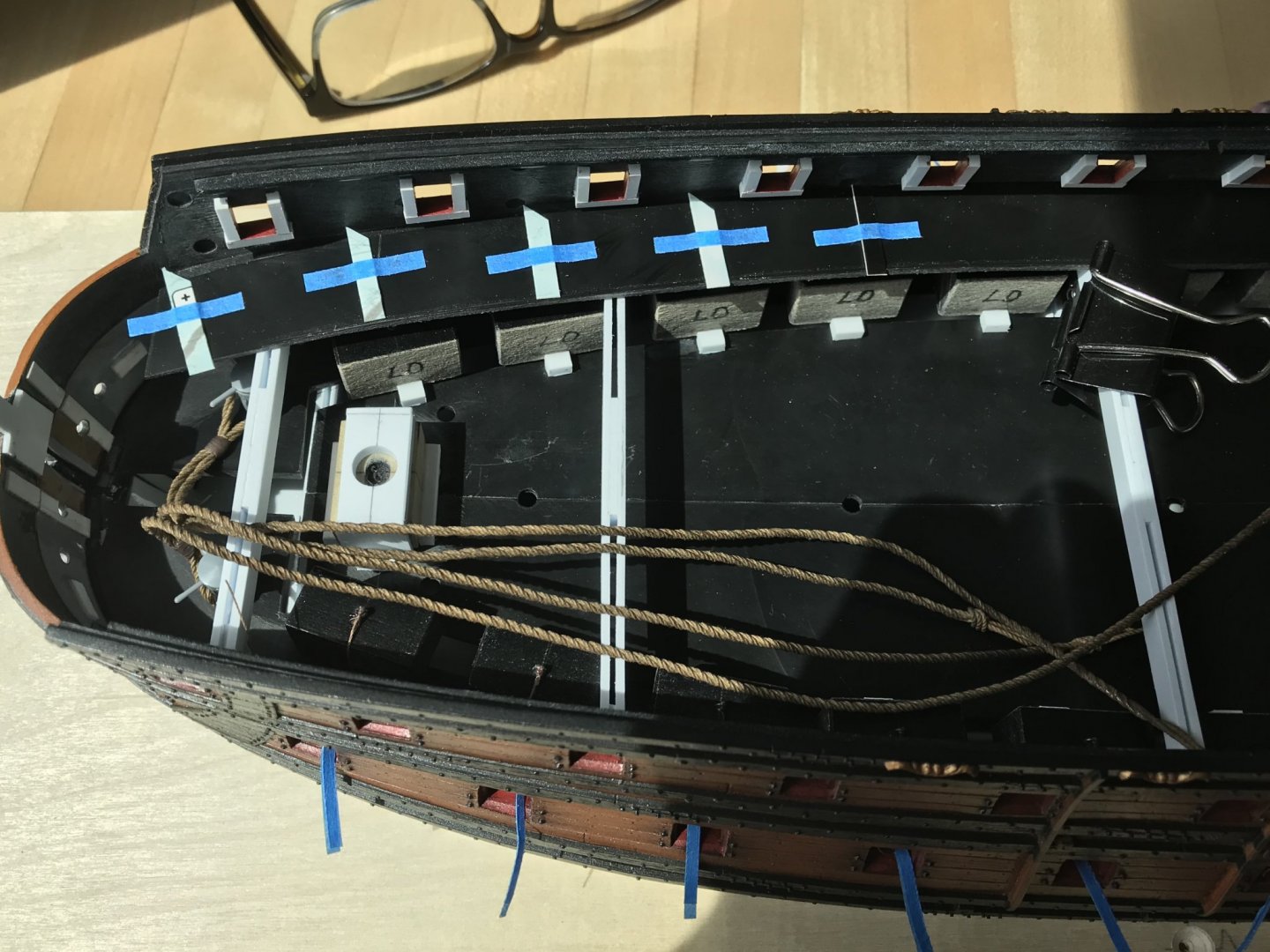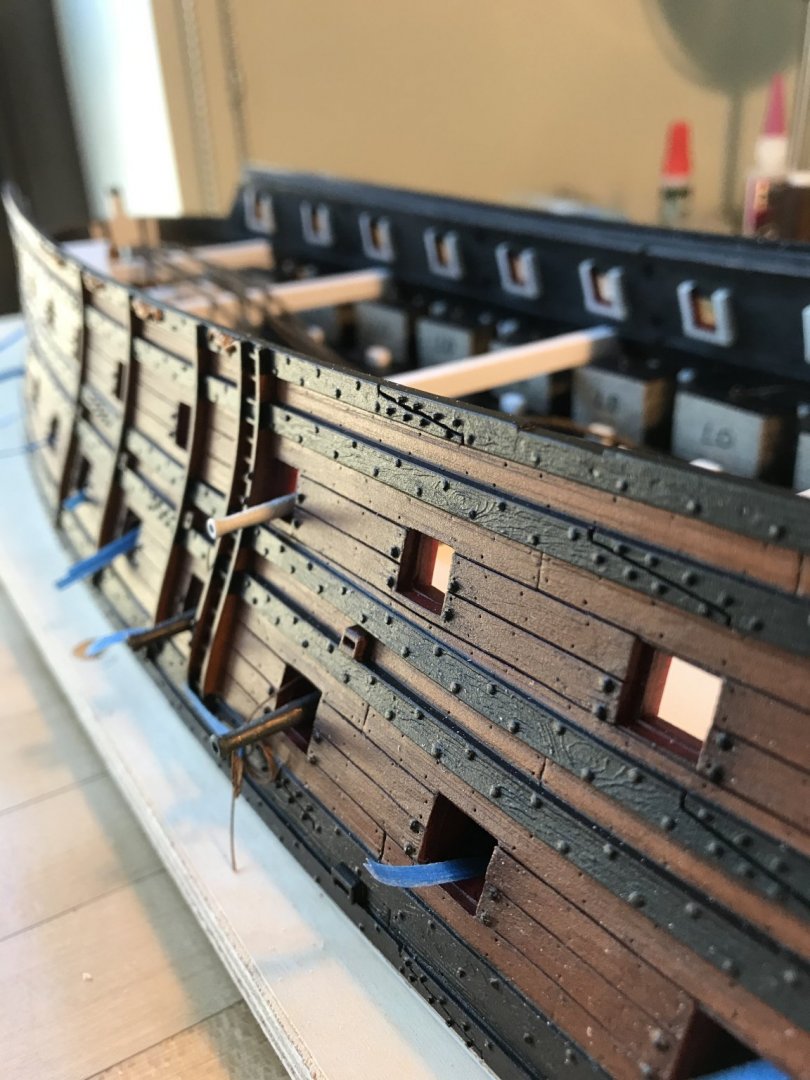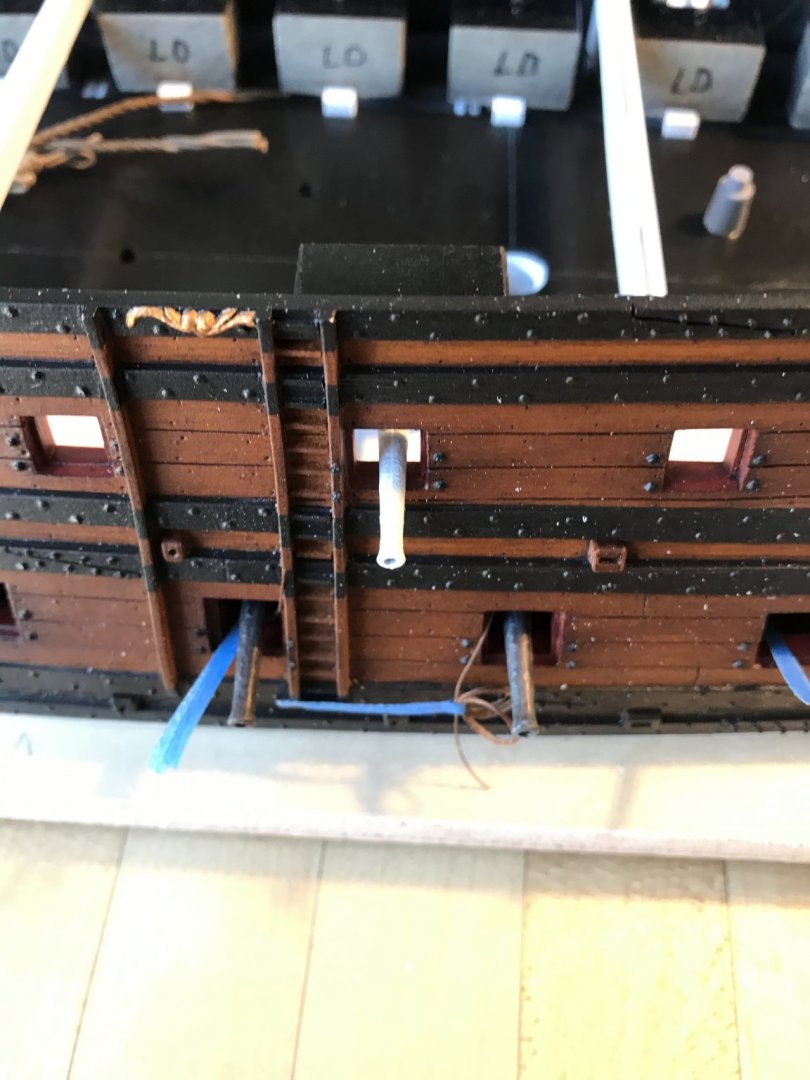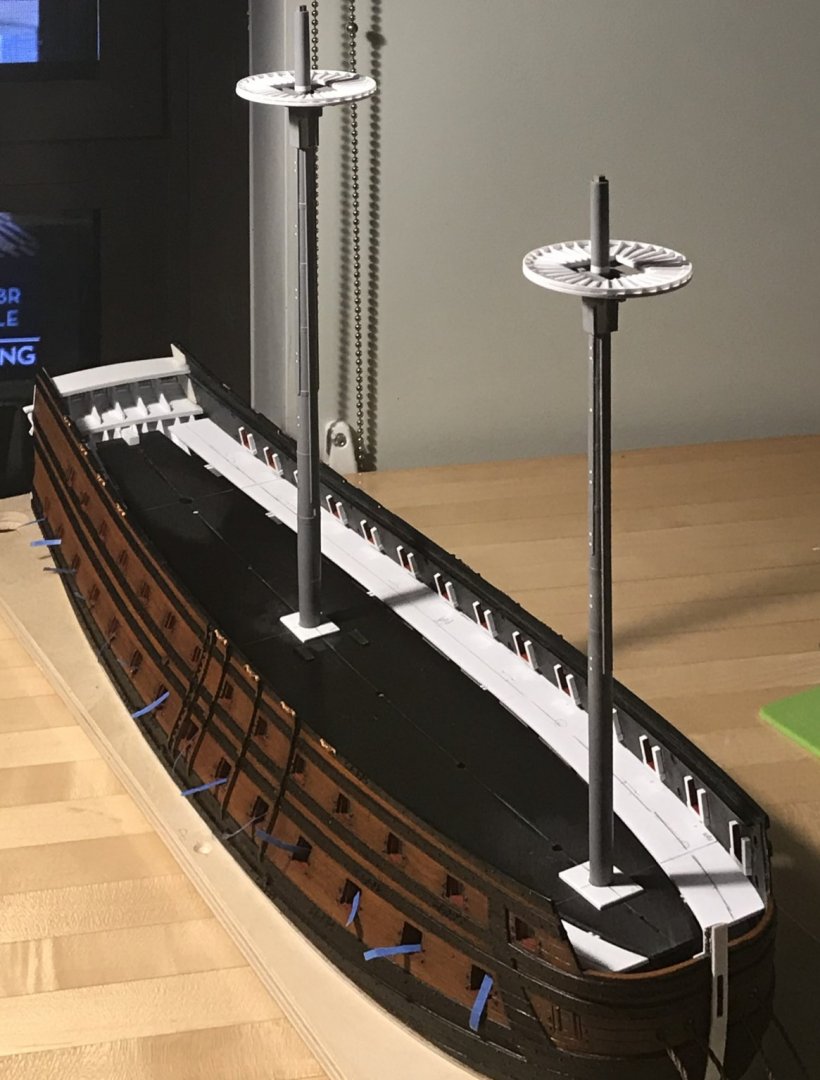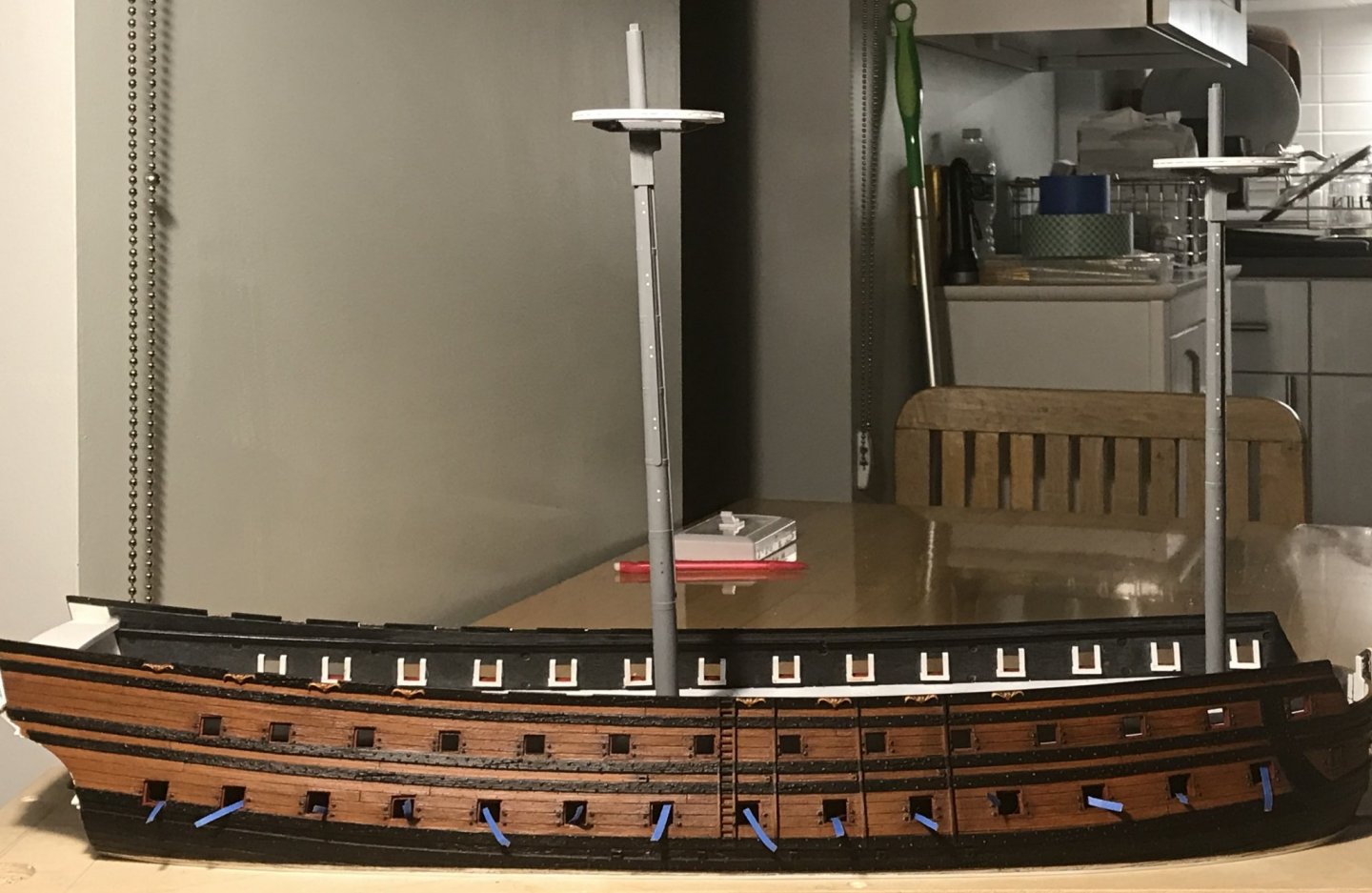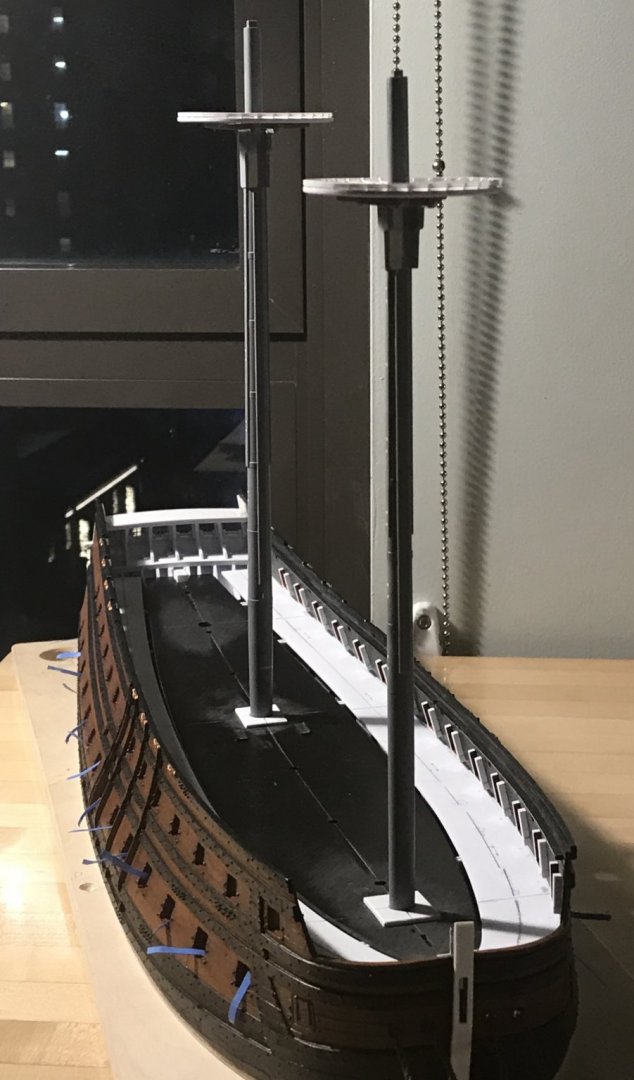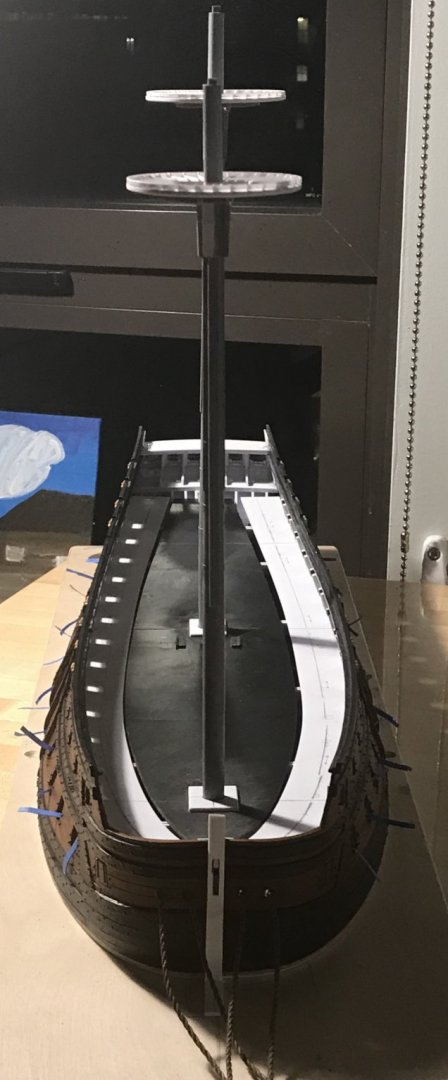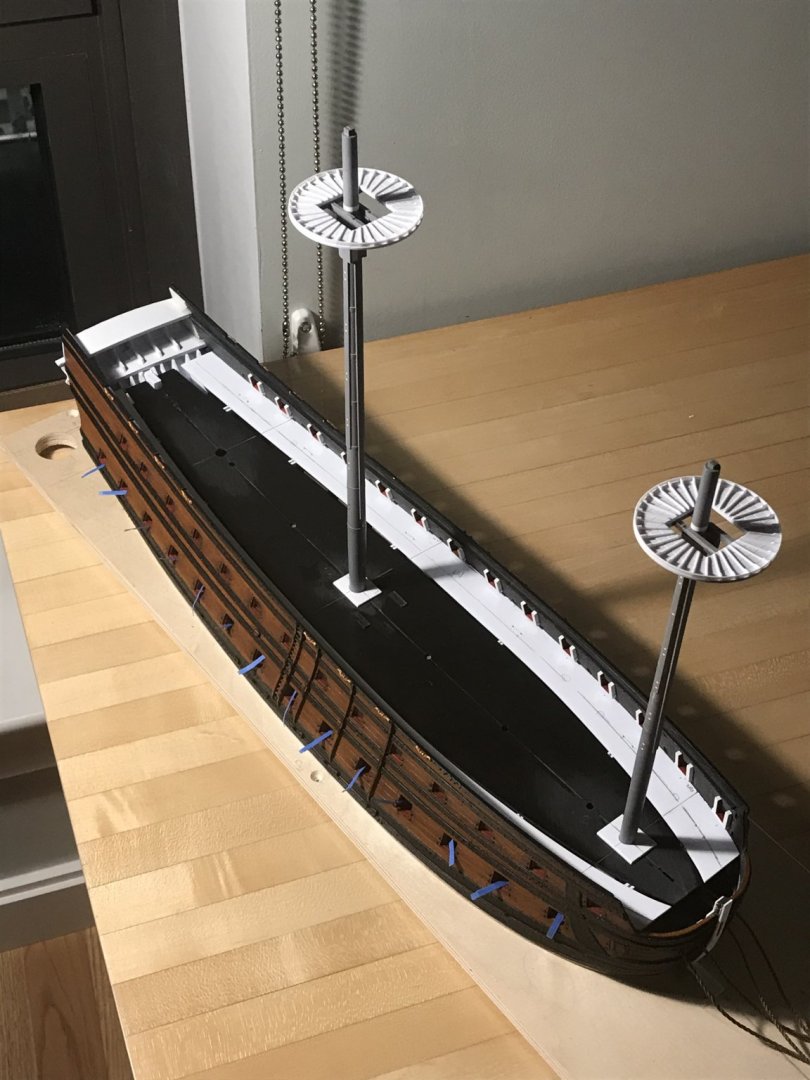-
Posts
3,292 -
Joined
-
Last visited
Content Type
Profiles
Forums
Gallery
Events
Everything posted by Hubac's Historian
-
Well, Mark, I rarely have any good Scotch in the house, as that habit would quickly become very expensive. When I do, I really love sherry cask finished Glenmorangie Lasanta. Mostly, though, I keep what I like to call maintenance Scotch blends like Dewars in the house, that are highly drinkable, not overly expensive, and equally inspirational. Also - never underestimate a good Irish whiskey! There are many affordable labels to choose from. Thank you, Henry! This project simply would not be happening without your help. Your hull and part donations made the hull expansion possible, as well as the improvement of many common fittings like the hatches. I sometimes wonder whether I could have cast resin bow and stern extensions from my own hull. I am skeptical that I could have made the bow work out so seamlessly because I still had to heat bend the bow extension pieces to match the hull curvature. I do not think this would be possible with resin. Also, the bond between the resin and plastic would be strictly mechanical, and I would be skeptical of the long-term prospects for the model. So, while I will certainly never be doing this again, I wouldn’t be doing it at all without your generosity, Henry. As for the time it takes to make all of the carvings, I often have significant pockets of downtime in my day that would not otherwise be wasted, but which I use to work on things like this. This is when I am freshest and best able to really concentrate. If all of the ornamental work had to happen in the evenings, I would probably still be constructing the frieze, and likely considering giving up on the project because the progress would be agonizingly too slow. As things stand, I am quite happy with the pace of the project, since I only really began constructing the model this past September. To finish the carvings, Vic, they get a final once-over scraping to remove any ridges, and then I brush them with a stiff bristle toothbrush to get rid of the fuzzies. Also, interestingly, Marc Yeu makes his own purpose specific carving tools for his Soleil Royal project. Clearly, his results are extraordinary, and the tools he makes are very clever. Other than moulding scrapers (thanks, Dan!), this plastic model doesn’t require too much specialized tooling. SR 1670 in wood, however, will challenge me to make a set of piano wire chisels and gouges.
- 2,696 replies
-
- heller
- soleil royal
-
(and 9 more)
Tagged with:
-
Thank you both very much! I will definitely be taking that approach when I have a chance to work in a larger scale. That will be when - despite our means to accommodate it, I begin my true MAGNUM OPUS of the fully framed, 1670 Soleil Royal in 1:48 scale or bigger!! - and, my first wife divorces me... And, then, I will need the big, loving eyes of Soleil Royal’s lady/hippocampus figurehead to carry me through to the glorious completion of the project. I can see those eyes now; gilded orbs of trust and un-relenting support. Passion knows no bounds! Neither does Scotch.
- 2,696 replies
-
- heller
- soleil royal
-
(and 9 more)
Tagged with:
-
Hi Mark, Unusually, I’m at a loss for words. However, I was looking at my favorite model of La Belle on Pinterest, by Olivier Gatine, when I saw the following picture: This picture reminded me of your earlier discussion, concerning intersecting mouldings from stern gallery to stern edge. I really don’t know what to say about this picture, other than it is an interesting illustration of the problem. Much as yourself, that Olivier Gatine is a sharp executioner of the details. ATB, Marc
-
I can appreciate your approach, David. That makes a lot of sense. What I do is an artifact of my furniture-making days at Steinway; the confluence of a clear design idea and the availability of prime material would present themselves, yet I may not have a fully developed idea of the whole ornamental program. Despite that, time was of the essence, so I’d just get busy making the piece, while leaving sufficient material allowances for the carvings. I’d just allow my subconscious to work on the problem, and eventually I’d have a unified ornamental scheme hit me like a bolt of lightning. Here, the process of relieving the face was a little amorphous, at first, but my subconscious has been working it out as the carving progresses. Now, I have a pretty good idea how to go about it. It’s always tricky, though, because there is so little material, and the best one can achieve is the mere suggestion of facial features, in this scale.
- 2,696 replies
-
- heller
- soleil royal
-
(and 9 more)
Tagged with:
-
It has been a good and productive day, as the figure rounds into form. For the next section, I am focused on the hips and abdomen, bordered by the breastbone and garland. It’s a small area, but surprisingly complex for conveying a sense of anatomy. The main thing to keep in mind is that this area gets divided into three levels of relief; the hips are the lowest level, while just slightly more proud is the lower abdomen, and topping all is the upper abdomen, which gets cut back rather sharply to create what will be the overhang of her breasts. The process involves all the same steps and techniques that have been described previously. If anything, most of what is happening here is a scraping to form with the hooked BEEBE. This photo montage shows something of the progression. I thought I had taken a few more pictures, nevertheless, here is what I have: Here, the upper abdominals are scribed in with a bit of a hard line. A few scrapes later, though, and they soften up appropriately: I keep forgetting to mention that I deliberately mount my carving blanks to the waffled side of my masonite tile. I do this because the grip of the double-stick tape is aggressive, And it needs to be for holding the work securely while you carve. However, the waffled surface reduces the gripping power of the tape enough to make extracting the carvings easy enough, without breaking them. That will be it for carving, until Monday. I need to give my cubital tunnel elbow a break, for a minute. I’ll catch up on the other blank, next week. Enjoy, as best you can, your weekend of restricted mobility, everyone!
- 2,696 replies
-
- heller
- soleil royal
-
(and 9 more)
Tagged with:
-
Thanks for that, Vic and EJ. As I say, videos would be tremendously more insightful, but these explanations open, at least, some window Into my process. Ultimately, a desire to get into all the tightest little corners, combined with an unwillingness to buy every carving knife on the planet, trained me to find the versatility in the few tools that I rely on. I think the main sacrifice, there, is speed.
- 2,696 replies
-
- heller
- soleil royal
-
(and 9 more)
Tagged with:
-
Alright, so it took me a moment to finish the tail on the port side figure, and then work the starboard side to the same point. The tails differ in small ways, but working the carvings in tandem helps ensure a degree of consistency from one side to the other. It is also helpful and faster, carving the second piece because all of the process you just worked through for the problems of that section are still fresh in your mind. The next section I concerned myself with is the flowing, billowy skirt, up to the lower edge of the bellflower garland. The process begins the same way, by cutting in the next line of demarcation, which is the bottom edge of the garland. In order to achieve this cutting-in, I begin with my smallest round Dremel burr, as before. This time, though, the particular shape of the bellflower lends itself well to stab-in cuts with my small, shallow sweep gouge: This single tool is incredibly versatile for small work, such as this. I can creep up to a line with a series of stabbing cuts, and the thumbnail edge allows me to roll into tight corners. I also use this tool for both concave and convex modeling, with either paring cuts or a scraping action. Next to the hooked BEEBE, this is the knife that I use the most. So after cleaning around the bellflower, this is what we have: I’ve smoothed over and slightly rounded over the surface of the skirt by paring and scraping with the Beebe, but really, I’ve only removed enough material to ease the transition into the line of demarcation, which is the bellflower. In the next picture, you can see that I completed the skirt modeling, to the right, but I’ve marked in the reference lines on the left skirt, to remind me how the folds and hollows need to be cut in: This process begins by using the smallest veiner I have to begin cutting-in the troughs of the hollows as far up as I can, before the tool interferes with the garland. Here is my veiner: If my small gouge is an 1/8”, across the sweep, this veiner cuts a 1/16” line. Once I have the basic direction of the trough cut-in with the veiner, I use my smallest ball-burr to deepen the troughs, and extend them up to the garland. These are just very light, controlled passes in the Dremel, on the lowest setting, until you are satisfied with the depth and overall shape of the trough. Oddly, I find this near-finish use of the Dremel much more difficult to control than using knives. The next to last step is to smooth the transition from trough into fold by using the gouge to scrape smooth micro-facets until you have a smooth natural-looking fold. I also like to use the edge of the BEEBE knife to take skewed, paring scrapes to further deepen the trough and smooth into the folds - especially near the garland, where the tip of the BEEBE can ride right along the line of demarcation. As Druxey noted, this final finishing of the modeling is best achieved in a raking light, so that you can best gauge the depth of your modeling and the smoothness of your transitions. The final step, on this particular carving exercise, was to undercut the hem of the skirt, just beneath the largest folds, and to both sides of the tail. This is achieved quite easily by scraping the tip of the BEEBE into the highest portion of the raised-fold edge. You won’t have to work this very deep or hard, in order to achieve the desired effect. When the carvings are complete, I’ll use a stiff-bristle toothbrush to break away any remaining fuzzies. The next section to tackle will be the upper torso and arms, followed by the garland, and finishing with the head, neck and wings - hardest for last. As always, thanks for looking in!
- 2,696 replies
-
- heller
- soleil royal
-
(and 9 more)
Tagged with:
-
Work on the middle deck is now complete. All of the main deck gussets are in place, now, and I have begun fitting the cambered main deck beams. These first two, are just aft of the main mast, and bookend the aft hatches. Now that I’m dealing, once again, with aspects of the model that are going to be seen - I am taking extra care to check and re-check measurements and maintain my centerline. Because of the necessity of framing around fixed openings in the deck, I have had to position shorter gussets over gun port openings, at times, and this has made for some interesting cutting-in of the beams. Generally, I only manage one beam a night before I am too tired to focus. As mentioned in a prior post, though, there are interesting a-symmetries creeping into the build; specifically, the measurement from center to the starboard upper bulwark base, in the waist, is as much as 3/32” less than that from center to port. This discrepancy diminishes toward the bow and stern, but it is still present. When you sight along the top of the bulwark base, your eye can read that the starboard hull is a bit flatter than to port. My only real concern, here, is that it will affect my plank layout, as the eye moves from center to the deck margins. I tried to figure out where I had gone wrong here, after cutting away the lower hull, at the start of the build. When laying out the plinth base, I had set the waterline at the widest point of the hull, 3 1/8” to each side of the centerline. I forget the exact transom measurement, but it was whatever I needed to ensure the space necessary for six windows, above the stern counter level. Here, the hull halves are taped in position so that I could do an interior and exterior tracing of their required positioning. I then glued in bow, center and transom doublings of the plinth base to ensure that I had firm indexing points, all along the hull length for the glue-up: The objective was to create a glue-up that didn’t require excess clamping or downward pressure. I am certain that - at least along the waterline - the hull halves are equidistant from the centerline. My only real conclusion, here, is that cutting away the lower hull released tension, unequally, from one hull half to the other, thus flattening one side more than the other. Another factor is likely the fact that my stem is slightly out of plumb, healing ever so slightly to port; in an effort to get the stems to mate perfectly, while the hull halves were on a dead-flat surface, I did some addition and subtraction of plastic along the bottom, forward edges of each hull half. This was an effort to compensate for my un-even, initial sanding of the waterline, when I cut away the lower hull with the bandsaw. While the stern post remains truly perpendicular, perhaps the pulling to port, at the stem, has contributed to a flattening of the hull on the starboard side. Anyway, despite these un-anticipated consequences, I have decided not to worry about it. What’s done is done. The masts are in-line with each other, and any relative discrepancies in their relationship to the ship sides will not be readily apparent. As for my deck layout, I have decided that, visually, the regular intervals of gun carriages, along with all of their accoutrements, will obscure whatever net difference there may be along the margin plank. While I may be able to adjust the plank layout a bit, to compensate, I’m not going to get too bent out of shape over the whole thing. I only mention it all as a cautionary tale for anyone else who may decide to take-on the madness of this sort of project. In other work, the figure carving proceeds nicely. I’ll have an update on that soon. Thank you all for the likes, comments and for looking in.
- 2,696 replies
-
- heller
- soleil royal
-
(and 9 more)
Tagged with:
-
Well, FC, taking an initial look-through at this project, I can fully appreciate why others here, at MSW, are concerned for your whereabouts. You are very talented! I’m late to the party, but I will read through the whole log and follow through to the end. Great work!
-
Excellent additional insights, Druxey, and thank you Dan and Mark. A video would be better, but hopefully what I’m trying to describe is sensible enough. And, Kurt, I think we can all attest the the devastation wrought with pool noodles by covert kids who want to spray is off out comfortable floatie!😉
- 2,696 replies
-
- heller
- soleil royal
-
(and 9 more)
Tagged with:
-
This is also a question of great interest to me.
- 1,035 replies
-
- royal katherine
- ship of the line
-
(and 1 more)
Tagged with:
-
You absolutely can do it, Stephen. The primary requirements are time, commitment to a standard, and the willingness to just keep at it. I designed and made my first carved piece in 2003. It was a decent sized inlay for a piece of furniture -approximately 12” X 6”. I worked very hard at it, and it turned out okay. Mostly, because I took my time. Over the years, I learned how to work smaller and smaller - although, never really faster. If it interests you, I would suggest doing a basic relief carving, in wood, and at a reasonable size, just to get your feet wet. There are plenty of ready—made designs in books, and of course, YouTube. And, to this day, I watch carving process videos on YouTube. I am particularly interested in the early American long-rifles of Pennsylvania. Today’s master-makers are experts at the art of low-relief carving. Many of these guys have videos, online, that take you step-by-step through their relief process. This guy, Jim Kibler, is particularly instructive in his method: Really, the techniques employed are applicable to any kind of carving, at any scale. His focus and attention to detail are very high. Once you get a feel for it, anything is possible.
- 2,696 replies
-
- heller
- soleil royal
-
(and 9 more)
Tagged with:
-
In this second installment, I’ll discuss the initial planning and approach that goes into modeling the carving, while introducing the tools that I use the most, and discussing the techniques that have given me good results. At the stage pictured, below, I’ve invested about four hours cleaning to my outlines on each carving. I’ve used the smallest diameter drill bit I have - roughly 1/64” - to get in-between the head, wings and arms. Doing so, even to this minimal degree will greatly ease the cutting-in later. The carving blanks have good symmetry. I made one small drilling error in the bell-flower garland, near the hand, on the left blank. In the end, this small mistake won’t be noticeable, and certainly it does not necessitate a redo of the blank. Below are the primary tools that I used, today, to begin carving the tail. With the exception of a few Dremel burrs that I use to do some of the initial wasting, most of the cutting-in and sculpting I do happens with my EXACTO (for deepening lines of demarcation), and my hooked BEEBE knife for paring, digging and scraping. This hooked knife, in particular, is invaluable throughout the sculpting process because its versatility enables you to achieve fine results without an arsenal of carving tools. The occasional drill bit also comes in handy when you need to define a small radius within the work - as, here, along the flowing hem of the figure’s blousy skirt. So - even though, at this point, I have made a number of similar sculptures for this project, every carving is unique and demands that you think your approach through before you begin. While not a fully rounded figure, this carving is, nonetheless, fairly involved, with the area around the head and wings providing the greatest challenge. Personally, I like to begin a carving in an area that is a little less daunting until I find my confidence, again, and the resulting momentum allows me to work through the carving by increasing degrees of difficulty. In this instance, I have decided that the tail is the best starting point because, while contoured, it is a shape that I fully understand, right now. Unfortunately, the line of demarcation, here, is the blousy skirt that has a somewhat involved hemline that one must clearly define, first. Bear in mind that the blank, in this case, starts out as 1/16” thick. As a general rule, I will reduce to 1/2 thickness along lines of demarcation, in order to convey a sense of depth. In this case, that means that the skirt steps down, roughly, 1/32” to the tail. In order to begin cutting in this line of demarcation (on the tail side of the line) I like to take the smallest round burr I have and run it in the Dremel at the next to lowest speed; because this is plastic, you don’t want to generate too much heat, thus making a molten mess of your waste. The absolute key to “relief” carving is to relieve an area for the waste to pare away easily, without having to apply too much pressure on the blade. To facilitate this, I run my Dremel burr along the line, but not on it. You want to get to within 1/32”, or so, of your line so that you can gently pare to the line with your knives. For the most part, I like to use my EXACTO to pare to lines, and the BEEBE to pare and scrape the surface down smoothly. Although it isn’t so evident in the picture below, I’m plunging the tail lower at the sides, than in the middle because, ultimately, I want the tail to take on a domed appearance. In the finished carving, it is this very slight rounding of a surface that creates the play of light and shadow that gives the carving a sense of depth. The other thing to be aware of is that, as you sculpt down through some of your reference lines, you will occasionally need to pencil-in a few guidelines as a reminder of where you are going. In the example below, I’ve penciled-in a crease line that ever so slightly favors one side of the tail, towards the top, but centers at the bottom, where it meets the foliate flipper. I have found that, sometimes, working just off-center enhances the dynamic “movement” of a carving. Also - however subtle they may be, hard crease lines define shadow and light in a way that benefits the finished carving. Developing a sense for this is simply in the doing of it, but it is useful to at least be aware of that, as you begin sculpting. Another design trick for creating a greater sense of movement and vitality is to create undulations or “waves” of varying depth. Some examples of where I have previously done this on this model are the motto banner and the rudder dolphin’s tail. Initially, it’s just a simple matter of using a Dremel side cutting, straight burr to create these waves: Note that the angle at which you introduce these undulations matters; it can either affirm natural movement or run contrary to our intuitive expectations of how tails behave. Once that’s established, you can begin really contouring the tail. Usually, I’ll begin a rough paring with the BEEBE. Then, I’ll smooth the surface and try to define my crease with the triangular And round needle files - so far as I can without cutting into adjacent sections of the work. Finally, I will scrape micro-facets with the BEEBE - particularly around the perimeter. This helps me achieve the soft rounding. The foliate tail “flipper” represents a small increase In degree of difficulty. Before I begin sculpting the leafy tail fronds, I want to achieve a sloping taper from the head of the flipper to its tip. This is easily achieved with an emory board. Next, I want to introduce a similar sense of movement with waving undulations, just as we did before with the tail body: Sculpting of the flipper fronds, themselves, begins by re-scoring the outline of each frond with your EXACTO blade. I like to “draw” a very light line with the blade, on the first pass. Then, I’ll make a few deeper, scoring cuts along this line. Finally, I’ll flip the blade and drag it through my score cut, with the spine of the blade leading the direction of the cut. In this fashion, the blade tip essentially engraves a successively deeper line into the plastic. As described, this same technique works essentially the same way on wood - particularly, across the grain. The more parallel your cut runs with wood grain, the more you will have to alternate your direction of cut Any time I’m trying to sculpt something small and leafy like this, I basically try to scrape two facets along a centerline, for each frond. Mainly, I use the BEEBE for this. I also like, where appropriate, to introduce concave hollows around round openings. There’s a small shallow gouge that I use for this, but I didn’t have that with me today. I’ll be discussing that more in the next installment. Basically, these few techniques will enable you to methodically work your way through any carving. I probably won’t do detailed updates of every step in the process, but I likely will discuss the bell-flower garland, as well as the head and wings, in some depth. Until then, be well and enjoy this extended American weekend!
- 2,696 replies
-
- heller
- soleil royal
-
(and 9 more)
Tagged with:
-
On the Ships of Scale site, a few members have expressed interest in my carving process. I’m still up in the air about creating a YouTube account for posting video content. I thought, though, that these Mer-Angels were a good opportunity to discuss my approach and technique in depth. The major benefit of what I do is that it doesn’t require a ton of specialized carving tools. Continue, below, for parts one and two of this series ______ I thought, perhaps, to demystify my carving process, that I would do short updates, as the carvings take shape. The first thing, whether you are working from a pre-established ornamental plan, or drawing the ornaments yourself - you are going to want to make sure that the ornamentation is appropriately scaled and detailed in the appropriate style of the nation and time period you are working from. Ultimately, the quality of all relief carving boils down to the quality of the design and layout. One aspect of model ship-building that begs for a good reference library is ship ornamentation. The single best book in my actual library, for this purpose, is Andy Peters’s book Ship Decoration 1630-1740. He covers each national style with sufficient depth to see the evolution of styles across this fairly long time period. I also have numerous books filled with pictures of contemporary models and period portraits by respected artists. What really helps me out, though, is curating several very large databases of period ship imagery on Pinterest. At the end of the day, the more you study the best examples of the shipcarvers’ art, the more fluent you will become with their oeuvre, and the better equipped you will be to draw it. My operating philosophy is that The point at which I can see something clearly enough in my mind to draw it, is also the point at which it becomes possible for me to make it. Because good carving is so time consuming, it is well-worth the extra time it takes to make extra copies of the ornamental plan so that you can edit directly to the plan, if you don’t like the direction, or slope of a line, for example, or if you find specific aspects of an ornament to be exaggerated. Once satisfied with your edits, you can make fresh photocopies, and this becomes your new pattern. Once I have a workable pattern, I paste it directly to my stock with a craft glue stick. It should be noted that almost everything I will say about carving these styrene ornaments applies equally to wood. The techniques involved in figure carving, though, are a little more involved. The first objective for one of these low-relief ornaments is to separate the ornament from the bulk of the waste. I find it easiest to drill a series of closely spaced holes all around the carving with a micro bit. Afterwards, it’s short work to connect the dots with a sharp utility knife. The next step is to set in all of your lines. In large, full-size relief carving, one would use a V-tool and mallet to do this. For something this small, I use my #11 Exacto, which I keep razor sharp. The difficulty, in this step, is that the design is full of many short radiuses, and pulling the blade through them can sometimes be quite difficult to stay on line. Having watched engravers, on YouTube, I have discovered a trick that works quite well, enabling me to scribe even the finest curved lines. Engravers use a swivel-vise to turn the work into the path of the graver, so that they only have to make minimal micro adjustments of direction, with their graver hand, while maintaining consistent pressure. What I do is very similar, with the exception that my hand holding the work (on a firm flat surface) pulls and turns the work AWAY FROM the blade tip, which my blade hand is holding with even pressure. With this technique, it is only necessary to make the smallest adjustments to blade direction, as you go. This all may sound difficult, but it becomes surprisingly easy with just a little practice. Just as one would practice cutting-in lines on a scrap piece of wood, take a small scrap of your material and draw a series of curved lines, so that you can practice the technique. Try it both ways; pulling material through and away from the blade, as well as, pulling the blade through the material. I think you will find that it is exceedingly difficult to pull the blade through the work (while holding the work stationary), and stay on-line. Almost invariably, the tension created by trying to control the large muscle groups in your blade arm, will cause you to lurch off track. In this scale, millimeters are everything, so even small distortions of line render the design illegible, once the paper is removed. Initially, I like to keep the paper on, while I fair to my lines, around the perimeter. I might begin by using a small Dremel drum sander to take away as much excess as possible. Sometimes the paper begins to delaminate and you are better off removing it. You can, at this point, soak the carving in running water to remove the paper (fine with plastic, but you will want to have used spray adhesive and solvent removal for wood). Once the paper is out of the way, I find it exceedingly helpful to darken (really darken) the whole surface in graphite. You want the pencil lead to get into your scribe lines. I then use my thumb to smudge the graphite into the lines. Doing so also lightens the field enough to see the lines more clearly. Once that’s settled, you work very carefully with a decent set of needle files to get as close to the lines as you can, all the way around the carving. Don’t worry, just now, about the fine corners and crevasses you can’t get to with the files. We’ll tackle that in the next installment.
- 2,696 replies
-
- heller
- soleil royal
-
(and 9 more)
Tagged with:
-
So, last night, I ordered a pair of small, brass micro-planes. The quality appears decent, on EBAY, and they weren’t terribly expensive. What I like about them is that the sole is flat for the middle third, but there’s an entry and exit relief that should facilitate light, fairing passes. We’ll see what comes of that. I needed a good small-work project, so I have decided to tackle the low-relief Mer-Angels that flank the upper finishing of the quarter galleries. I’m carving these in 1/16” white styrene, and I will begin with the aft-most pair: It’s good to carve like-figures in tandem, for the sake of consistency. The forward pair require a little re-drafting, so that they don’t interfere with my aft-most octagonal port. Anyway, this should be a fun little bit of carving.
- 2,696 replies
-
- heller
- soleil royal
-
(and 9 more)
Tagged with:
-
Hi Kudin- I love your videos! On this most recent video, I have a question for clarification: it seems that you are gluing your deck planking directly to the paper plan layout which, itself, must be glued to the sub-decking. What adhesive of paper to sub-decking do you use to ensure there’s no de-lamination? Clearly there are tremendous advantages to being able to taper planking directly to the layout, in-situ.
-
Thanks for the reminder, Jan. Yes, I am also considering this approach - particularly with the top and t’gallant masts because you automatically have the squared foot that the masts require. It also enables me to mill perfectly straight stock, initially, rather than having to weed through any number of dowels, searching for straight examples. I’ve always wanted a mini violin maker’s plane, and this would be a great excuse to go out and buy one.
- 2,696 replies
-
- heller
- soleil royal
-
(and 9 more)
Tagged with:
-
Hi Mark - I also prefer the first figurehead, but I do think the actual ship would not have been launched without arms, as they would add gesture and expression to the figure. On the plus side, although it certainly begs a little due diligence, I suspect that her arms would be bare; or, at most, only short tunic sleeves.
-
Hi Jonathan - can you remind me of the sail paper, please? Is it Modelspan? As for authentic sail color, perhaps take a look at the photo-log of Hermione on her maiden voyage across the Atlantic, after completion of her construction. That will likely give you a fair idea of realistic weathering.
-
Work on the middle deck is coming along nicely. As mentioned, earlier, I found it much simpler to re-make the dummy carriage platforms from scratch, in order to achieve a close scribe without sacrificing platform depth. I used this simple scribing method to arrive at a faithful pattern for each side: You can see the relative flattening of the ship’s sides, here, with the new pattern mapped-out on white styrene: Once I had achieved a close scribe for each side platform, and before gluing them in place, I checked for the ideal positioning of the dummy carriage blocks, along the whole broadside. On the lower deck, my blocks all follow a uniform line, as they all butt-up against a raised lip at the back edge of the platforms. The middle deck presents a somewhat different reality, as the outward re-curve of the hull, in the area of the anchor lining, would make the barrel projection seem too short, if I were to simply place all of the dummy carriages at a uniform distance from the port opening. How’s that for a run-on sentence?! So, testing the depth from port to port, I discovered that the forward 5 dummy gun carriages needed to be staggered closer to the port openings in increments up to 1/16”. Splitting hairs? Yes. The result, though, will be a finished projection like this, relative to the lower battery: The added benefit of remaking the side platforms is that they are deep enough to adequately support the carriage blocks without any supplemental blocking. With all of that settled, I glued-in the side platforms and center deck sections, as before - taking care to consider the next step of raking the masts. Again - because the masts have been raised, their tapered lower diameter no longer corresponds with the openings at each center deck section level. My solution is to make mast plates that will enable me to align each mast on the ship centerline, while also establishing the rake. With Lemineur’s masting plan of the St. Philippe at hand, I set the rake for the foremast as nearly perpendicular to the waterline as eye and square could ascertain. I will still have some wiggle room to adjust the foremast, if necessary, at the main deck level; the foremast step is not even an inch below this first mast plate, and the fit is deliberately just a hair slack. The main mast is raked aft so that the main top is sensibly level to the waterline, while also accounting for the upward trajectory of the top and t’gallant masts. Here are the relative layout of mast rakes and top heights from a variety of angles: Without the upper deck and bulwarks in place to complete the picture, these mast heights may appear exaggerated, but I am confident that this impression will trend favorably as the model continues to take shape. In other works, the sprit, fore, main and mizzen tops are now complete, and I have made up all of the middle-deck dummy carriages - complete with shims for height, and lid lanyards. I will wait to set the dummy carriages until after I have made the gusset supports for the main deck beams. Placing those beams will require a little thoughtful layout, as they must accurately frame the openings for the main deck hatches and gangway. The beams around the gangway will have to be realistically sided, as they will be partially visible. So, onward and upward we will go. Thank you for the likes, your interest and for looking in!
- 2,696 replies
-
- heller
- soleil royal
-
(and 9 more)
Tagged with:
-
Really nicely proportioned carriages, and excellent consistency of effort and standards.
About us
Modelshipworld - Advancing Ship Modeling through Research
SSL Secured
Your security is important for us so this Website is SSL-Secured
NRG Mailing Address
Nautical Research Guild
237 South Lincoln Street
Westmont IL, 60559-1917
Model Ship World ® and the MSW logo are Registered Trademarks, and belong to the Nautical Research Guild (United States Patent and Trademark Office: No. 6,929,264 & No. 6,929,274, registered Dec. 20, 2022)
Helpful Links
About the NRG
If you enjoy building ship models that are historically accurate as well as beautiful, then The Nautical Research Guild (NRG) is just right for you.
The Guild is a non-profit educational organization whose mission is to “Advance Ship Modeling Through Research”. We provide support to our members in their efforts to raise the quality of their model ships.
The Nautical Research Guild has published our world-renowned quarterly magazine, The Nautical Research Journal, since 1955. The pages of the Journal are full of articles by accomplished ship modelers who show you how they create those exquisite details on their models, and by maritime historians who show you the correct details to build. The Journal is available in both print and digital editions. Go to the NRG web site (www.thenrg.org) to download a complimentary digital copy of the Journal. The NRG also publishes plan sets, books and compilations of back issues of the Journal and the former Ships in Scale and Model Ship Builder magazines.




